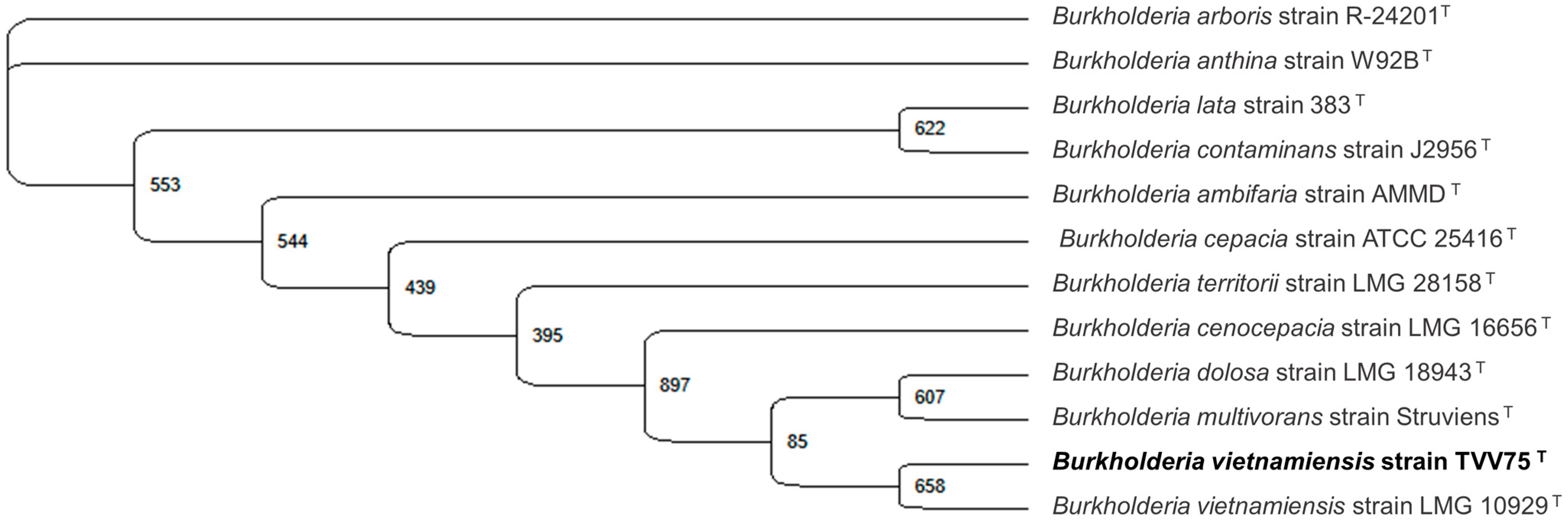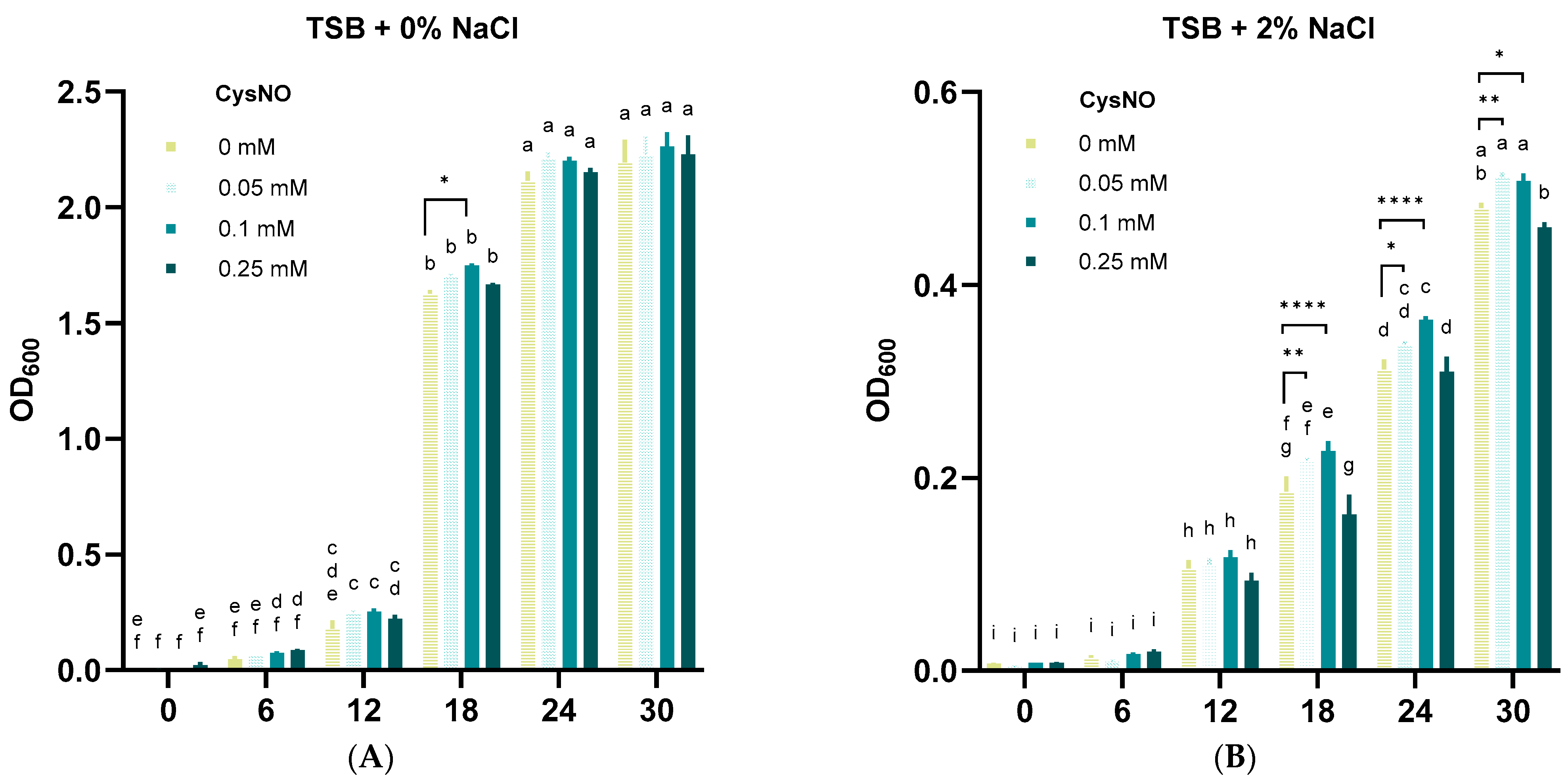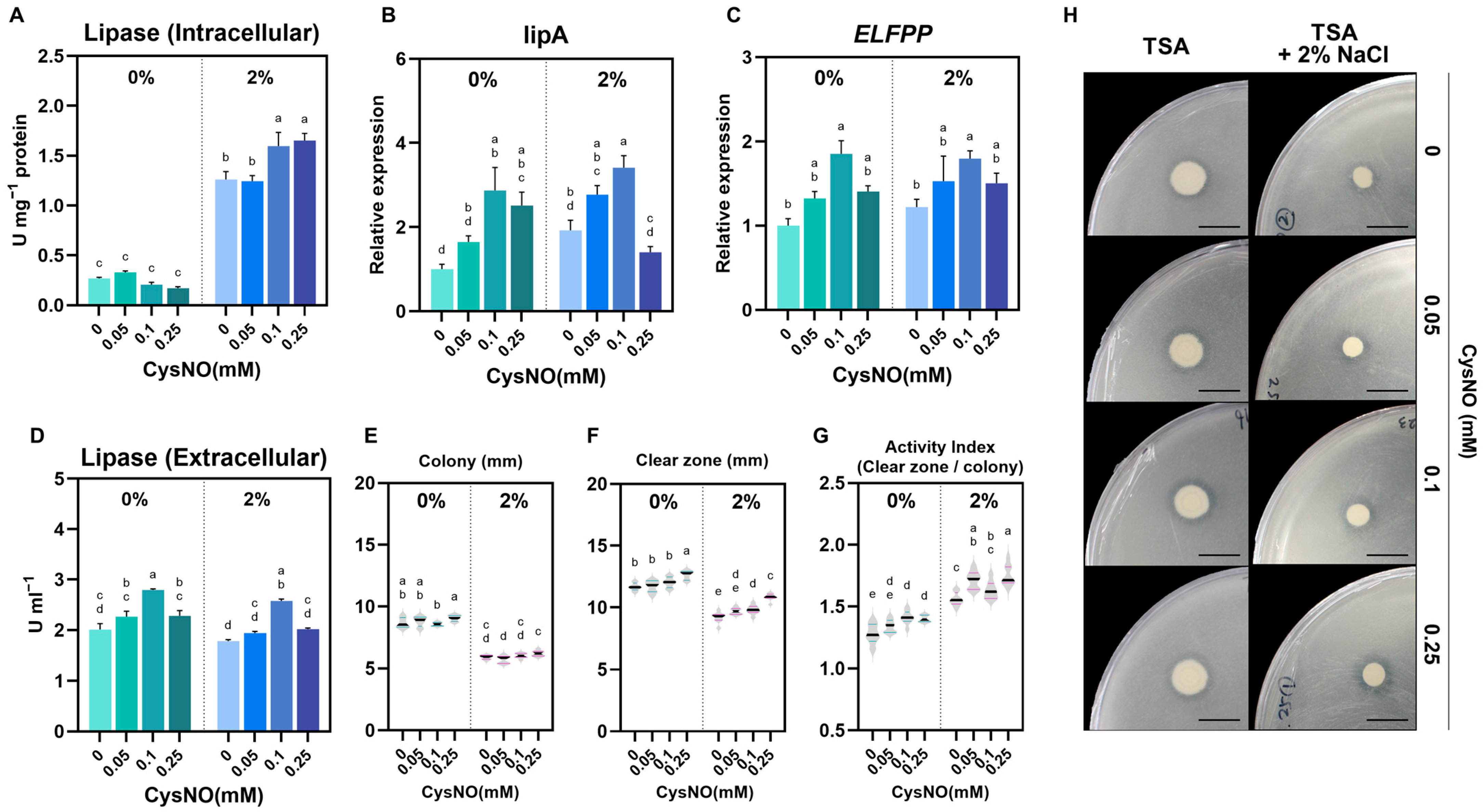S-Nitrosocysteine Modulates Nitrate-Mediated Redox Balance and Lipase Enzyme Activities in Food-Waste-Degrading Burkholderia vietnamiensis TVV75 to Deter Salt Stress
Abstract
1. Introduction
2. Materials and Methods
2.1. Isolation and Identification of Food Waste-Degrading Bacteria
2.2. NO-Treated Bacterial Growth Assessment Under Salt Stress
2.3. CYTO9/PI Cell Viability Assay
2.4. Enzyme Extraction
2.5. Nitrate Reductase Activity and Nitrite Determination
2.6. Measurement of Hydrogen Peroxide and Malondialdehyde
2.7. Antioxidant Activity Assay
2.8. Lipase Activity Assays
2.9. Relative Gene Expression Analysis
3. Results
3.1. Isolation and Molecular Identification of Strains
3.2. CysNO Protected B. vietnamiensis TVV75’s Growth Under NaCl Stress
3.3. CysNO Reduced Cell Death Under NaCl Stress
3.4. CysNO Application Improved ROS Detoxification Under NaCl Stress
3.5. CysNO Application Altered Nitrogen Metabolism to Protect the Bacterial Cells Under NaCl Stress
3.6. CysNO Application Improved Lipase Activity Under NaCl Stress
4. Discussion
5. Conclusions
Supplementary Materials
Author Contributions
Funding
Institutional Review Board Statement
Informed Consent Statement
Data Availability Statement
Acknowledgments
Conflicts of Interest
Appendix A
| Name | Sequence |
|---|---|
| gyrB_F | TCGGGCAAGGAAGACGATT |
| gyrB_R | CTGTCGTTCCACTGCATCG |
| nirB_F | CGACCGCTTCCTGATGTTCT |
| nirB_R | GCATCGCTGTTCACGAAGTG |
| nirD_F | GCCGTTGTACAAGCAGCATT |
| nirD_R | ATCCACACGAAACCGTCCTC |
| narG_F | AGCTGTATCAGGACCATGCG |
| narG_R | TTGTCCGTGTAGGTGCTGTG |
| narH_F | TACGGGCAGTTCGAGAACAC |
| narH_R | GAAGATGCACTTCTCGGCCT |
| hmp_F | AGCTTGAAGTTCGCATGGGT |
| hmp_R | AGCAGATTCGCCAGTACAGC |
| treZ_F | CTGTCGTCTCTAGCAGCACT |
| treZ_R | ATCAGGATGCCGATACGTGG |
| osmC1_F | CGAAGGACAGCAATACGTGC |
| osmC1_R | CAGTTCAGCGTCGTTTCGAT |
| osmC2_F | GCTGAAACAACCGTGATCGG |
| osmC2_R | GCATGGCGAACACAAGTACC |
| lipA_F | GCTGGATCGATCACCGGAAT |
| lipA_R | GCAACAACACGAACCAGGAC |
| ELFPP_F | CTCTGGAACGCCGACAGATT |
| ELFPP_R | TCAGTGGTACGGCATACGTG |
References
- van Dijk, M.; Morley, T.; Rau, M.L.; Saghai, Y. A meta-analysis of projected global food demand and population at risk of hunger for the period 2010–2050. Nat. Food 2021, 2, 494–501. [Google Scholar] [CrossRef]
- UNEP. United Nations Environment Programme. Food Waste Index Report 2024. Nairobi. 2024. Available online: https://www.unep.org/resources/publication/food-waste-index-report-2024 (accessed on 2 September 2025).
- Kim, M.H.; Kim, J.W. Comparison through a LCA evaluation analysis of food waste disposal options from the perspective of global warming and resource recovery. Sci. Total Environ. 2010, 408, 3998–4006. [Google Scholar] [CrossRef] [PubMed]
- Lee, E.; Shurson, G.; Oh, S.-H.; Jang, J.-C. The Management of Food Waste Recycling for a Sustainable Future: A Case Study on South Korea. Sustainability 2024, 16, 854. [Google Scholar] [CrossRef]
- Jang, S.-h. Aerobic Decomposition of Food Waste Using a Demestic Composter and Development of Odor Removal Strategy; Graduate School of Myongji University: Seoul, Republic of Korea, 2017. [Google Scholar]
- Tae-Gwan, L.; Kwon, H.-J. An Experimental Study on the Treatment of Household Food Waste Using Microorganisms. J. Korean Soc. Water Sci. Technol. 2017, 25, 31–40. [Google Scholar] [CrossRef]
- Fan, Y.V.; Lee, C.T.; Klemeš, J.J.; Chua, L.S.; Sarmidi, M.R.; Leow, C.W. Evaluation of Effective Microorganisms on home scale organic waste composting. J. Environ. Manag. 2018, 216, 41–48. [Google Scholar] [CrossRef] [PubMed]
- Rastogi, M.; Nandal, M.; Khosla, B. Microbes as vital additives for solid waste composting. Heliyon 2020, 6, e03343. [Google Scholar] [CrossRef]
- Lee, J.-H.; Kang, Y.-G.; Luyima, D.; Park, S.-J.; Oh, T.-K.; Lee, C.H. Characteristics of food waste: Water and salinity contents. Korean J. Agric. Sci. 2020, 47, 375–380. [Google Scholar] [CrossRef]
- Bremer, E.; Krämer, R. Responses of Microorganisms to Osmotic Stress. Annu. Rev. Microbiol. 2019, 73, 313–334. [Google Scholar] [CrossRef]
- Wood, J.M. Bacterial responses to osmotic challenges. J. Gen. Physiol. 2015, 145, 381–388. [Google Scholar] [CrossRef]
- Bellenberg, S.; Huynh, D.; Poetsch, A.; Sand, W.; Vera, M. Proteomics Reveal Enhanced Oxidative Stress Responses and Metabolic Adaptation in Acidithiobacillus ferrooxidans Biofilm Cells on Pyrite. Front. Microbiol. 2019, 10, 592. [Google Scholar] [CrossRef]
- Rivera-Araya, J.; Pollender, A.; Huynh, D.; Schlömann, M.; Chávez, R.; Levicán, G. Osmotic Imbalance, Cytoplasm Acidification and Oxidative Stress Induction Support the High Toxicity of Chloride in Acidophilic Bacteria. Front. Microbiol. 2019, 10, 2455. [Google Scholar] [CrossRef]
- Addorisio, S.R.; Shteynberg, R.; Dasilva, M.; Mixon, J.; Mucciarone, K.N.; Vu, L.; Arsenault, K.; Briand, V.; Parker, S.; Smith, S.; et al. Oxidative Stress Response in Bacteria: A Review. Fine Focus 2022, 8, 36–46. [Google Scholar] [CrossRef]
- Huang, J.; Pan, Y.; Liu, L.; Liang, J.; Wu, L.; Zhu, H.; Zhang, P. High salinity slowed organic acid production from acidogenic fermentation of kitchen wastewater by shaping functional bacterial community. J. Environ. Manag. 2022, 310, 114765. [Google Scholar] [CrossRef]
- Noctor, G.; Reichheld, J.-P.; Foyer, C.H. ROS-related redox regulation and signaling in plants. Semin. Cell Dev. Biol. 2018, 80, 3–12. [Google Scholar] [CrossRef]
- Hancock, J.T.; Veal, D. Nitric oxide, other reactive signalling compounds, redox, and reductive stress. J. Exp. Bot. 2021, 72, 819–829. [Google Scholar] [CrossRef] [PubMed]
- Domingos, P.; Prado, A.M.; Wong, A.; Gehring, C.; Feijo, J.A. Nitric Oxide: A Multitasked Signaling Gas in Plants. Mol. Plant 2015, 8, 506–520. [Google Scholar] [CrossRef] [PubMed]
- Tahjib-Ul-Arif, M.; Wei, X.; Jahan, I.; Hasanuzzaman, M.; Sabuj, Z.H.; Zulfiqar, F.; Chen, J.; Iqbal, R.; Dastogeer, K.M.G.; Sohag, A.A.M.; et al. Exogenous nitric oxide promotes salinity tolerance in plants: A meta-analysis. Front. Plant Sci. 2022, 13, 957735. [Google Scholar] [CrossRef] [PubMed]
- Shang, J.X.; Li, X.; Li, C.; Zhao, L. The Role of Nitric Oxide in Plant Responses to Salt Stress. Int. J. Mol. Sci. 2022, 23, 6167. [Google Scholar] [CrossRef]
- Mariyam, S.; Bhardwaj, R.; Khan, N.A.; Sahi, S.V.; Seth, C.S. Review on nitric oxide at the forefront of rapid systemic signaling in mitigation of salinity stress in plants: Crosstalk with calcium and hydrogen peroxide. Plant Sci. 2023, 336, 111835. [Google Scholar] [CrossRef]
- Wei, L.; Liao, W.; Zhong, Y.; Tian, Y.; Wei, S.; Liu, Y. NO-mediated protein S-nitrosylation under salt stress: Role and mechanism. Plant Sci. 2024, 338, 111927. [Google Scholar] [CrossRef]
- Garrido-Amador, P.; Stortenbeker, N.; Wessels, H.J.C.T.; Speth, D.R.; Garcia-Heredia, I.; Kartal, B. Enrichment and characterization of a nitric oxide-reducing microbial community in a continuous bioreactor. Nat. Microbiol. 2023, 8, 1574–1586, Correction in Nat. Microbiol. 2024, 9, 1631. https://doi.org/10.1038/s41564-024-01602-3. [Google Scholar] [CrossRef]
- Arora, D.P.; Hossain, S.; Xu, Y.; Boon, E.M. Nitric Oxide Regulation of Bacterial Biofilms. Biochemistry 2015, 54, 3717–3728. [Google Scholar] [CrossRef]
- Tian, Y.; Tian, X.; Li, T.; Wang, W. Overview of the effects and mechanisms of NO and its donors on biofilms. Crit. Rev. Food Sci. Nutr. 2025, 65, 647–666. [Google Scholar] [CrossRef]
- Roberts, J.M.; Milo, S.; Metcalf, D.G. Harnessing the Power of Our Immune System: The Antimicrobial and Antibiofilm Properties of Nitric Oxide. Microorganisms 2024, 12, 2543. [Google Scholar] [CrossRef]
- Andrabi, S.M.; Sharma, N.S.; Karan, A.; Shahriar, S.M.S.; Cordon, B.; Ma, B.; Xie, J. Nitric Oxide: Physiological Functions, Delivery, and Biomedical Applications. Adv. Sci. 2023, 10, 2303259. [Google Scholar] [CrossRef]
- Poole, R.K. Nitric oxide and nitrosative stress tolerance in bacteria. Biochem. Soc. Trans. 2005, 33, 176–180. [Google Scholar] [CrossRef]
- Hou, L.; Zhao, M.; Huang, C.; Wu, X.; Zhang, J. Nitric Oxide Improves the Tolerance of Pleurotus ostreatus to Heat Stress by Inhibiting Mitochondrial Aconitase. Appl. Environ. Microbiol. 2020, 86, e02303-19. [Google Scholar] [CrossRef]
- Baptista, J.M.; Justino, M.C.; Melo, A.M.; Teixeira, M.; Saraiva, L.M. Oxidative stress modulates the nitric oxide defense promoted by Escherichia coli flavorubredoxin. J. Bacteriol. 2012, 194, 3611–3617. [Google Scholar] [CrossRef] [PubMed]
- Nunoshiba, T.; DeRojas-Walker, T.; Tannenbaum, S.R.; Demple, B. Roles of nitric oxide in inducible resistance of Escherichia coli to activated murine macrophages. Infect. Immun. 1995, 63, 794–798. [Google Scholar] [CrossRef] [PubMed]
- Gusarov, I.; Nudler, E. NO-mediated cytoprotection: Instant adaptation to oxidative stress in bacteria. Proc. Natl. Acad. Sci. USA 2005, 102, 13855–13860. [Google Scholar] [CrossRef] [PubMed]
- Yu, N.-N.; Ketya, W.; Park, G. Intracellular Nitric Oxide and cAMP Are Involved in Cellulolytic Enzyme Production in Neurospora crassa. Int. J. Mol. Sci. 2023, 24, 4503. [Google Scholar] [CrossRef]
- Taskin, M.; Unver, Y.; Yildiz, M.; Ortucu, S.; Askin, H. Nitric oxide: A novel inducer for enhancement of microbial lipase production. Bioprocess Biosyst. Eng. 2016, 39, 1671–1678. [Google Scholar] [CrossRef] [PubMed]
- Okonechnikov, K.; Golosova, O.; Fursov, M.; The UGENE Team. Unipro UGENE: A unified bioinformatics toolkit. Bioinformatics 2012, 28, 1166–1167. [Google Scholar] [CrossRef]
- Boulos, L.; Prévost, M.; Barbeau, B.; Coallier, J.; Desjardins, R. LIVE/DEAD® BacLight™: Application of a new rapid staining method for direct enumeration of viable and total bacteria in drinking water. J. Microbiol. Methods 1999, 37, 77–86. [Google Scholar] [CrossRef] [PubMed]
- Doerner, P.A.; Sousa, M.C. Extreme Dynamics in the BamA β-Barrel Seam. Biochemistry 2017, 56, 3142–3149. [Google Scholar] [CrossRef]
- Park, B.S.; Song, J.T.; Seo, H.S. Arabidopsis nitrate reductase activity is stimulated by the E3 SUMO ligase AtSIZ1. Nat. Commun. 2011, 2, 400. [Google Scholar] [CrossRef] [PubMed]
- Gusarov, I.; Starodubtseva, M.; Wang, Z.-Q.; McQuade, L.; Lippard, S.J.; Stuehr, D.J.; Nudler, E. Bacterial Nitric-oxide Synthases Operate without a Dedicated Redox Partner. J. Biol. Chem. 2008, 283, 13140–13147. [Google Scholar] [CrossRef]
- Velikova, V.; Yordanov, I.; Edreva, A. Oxidative stress and some antioxidant systems in acid rain-treated bean plants: Protective role of exogenous polyamines. Plant Sci. 2000, 151, 59–66. [Google Scholar] [CrossRef]
- Beauchamp, C.; Fridovich, I. Superoxide dismutase: Improved assays and an assay applicable to acrylamide gels. Anal. Biochem. 1971, 44, 276–287. [Google Scholar] [CrossRef]
- Gupta, N.; Rathi, P.; Gupta, R. Simplified para-nitrophenyl palmitate assay for lipases and esterases. Anal. Biochem. 2002, 311, 98–99. [Google Scholar] [CrossRef]
- Sharma, P.; Sharma, N.; Pathania, S.; Handa, S. Purification and characterization of lipase by Bacillus methylotrophicus PS3 under submerged fermentation and its application in detergent industry. J. Genet. Eng. Biotechnol. 2017, 15, 369–377. [Google Scholar] [CrossRef] [PubMed]
- Ahmed, M.S.; Ahmad, S.A.; Shukor, M.Y.; Yusof, M.T. Statistical Optimisation of Used-Cooking-Oil Degradation by Burkholderia vietnamiensis AQ5-12 and Burkholderia sp. AQ5-13. Processes 2022, 10, 2178. [Google Scholar] [CrossRef]
- Tongco, J.V.; Kim, S.; Oh, B.-R.; Heo, S.-Y.; Lee, J.; Hwang, S. Enhancement of Hydrolysis and Biogas Production of Primary Sludge by Use of Mixtures of Protease and Lipase. Biotechnol. Bioprocess Eng. 2020, 25, 132–140. [Google Scholar] [CrossRef]
- Leibniz Institut DSMZ-Deutsche Sammlung von Mikroorganismen und Zellkulturen GmbH. BacDive—The Bacterial Diversity Metadatabase: Burkholderia vietnamiensis DSM 11303 (Strain TVV75). 2025. Available online: https://bacdive.dsmz.de/pdf-view/1939?site=pdf_view&id=1939&doi=doi%3A10.13145%2Fbacdive1939.20250331.9.3 (accessed on 11 October 2025).
- Zhang, X.; Khalid, M.; Menhas, S.; Chi, Y.; Yang, X.; Chu, S.; Zhou, P.; Zhang, D. Insights into effects of salt stress on the oil-degradation capacity, cell response, and key metabolic pathways of Bacillus sp. YM1 isolated from oily food waste compost. Chemosphere 2023, 341, 140092. [Google Scholar] [CrossRef]
- Berney, M.; Hammes, F.; Bosshard, F.; Weilenmann, H.U.; Egli, T. Assessment and interpretation of bacterial viability by using the LIVE/DEAD BacLight Kit in combination with flow cytometry. Appl. Environ. Microbiol. 2007, 73, 3283–3290. [Google Scholar] [CrossRef] [PubMed]
- Zhao, X.; Drlica, K. Reactive oxygen species and the bacterial response to lethal stress. Curr. Opin. Microbiol. 2014, 21, 1–6. [Google Scholar] [CrossRef] [PubMed]
- Farnese, F.S.; Menezes-Silva, P.E.; Gusman, G.S.; Oliveira, J.A. When Bad Guys Become Good Ones: The Key Role of Reactive Oxygen Species and Nitric Oxide in the Plant Responses to Abiotic Stress. Front. Plant Sci. 2016, 7, 471. [Google Scholar] [CrossRef]
- Li, X.; Wang, A.; Wan, W.; Luo, X.; Zheng, L.; He, G.; Huang, D.; Chen, W.; Huang, Q. High Salinity Inhibits Soil Bacterial Community Mediating Nitrogen Cycling. Appl. Environ. Microbiol. 2021, 87, e0136621. [Google Scholar] [CrossRef]
- Moreno-Vivián, C.; Cabello, P.; Martínez-Luque, M.; Blasco, R.; Castillo, F. Prokaryotic Nitrate Reduction: Molecular Properties and Functional Distinction among Bacterial Nitrate Reductases. J. Bacteriol. 1999, 181, 6573–6584. [Google Scholar] [CrossRef]
- Tavill, G. Industry challenges and approaches to food waste. Physiol. Behav. 2020, 223, 112993. [Google Scholar] [CrossRef]
- Mirabella, N.; Castellani, V.; Sala, S. Current options for the valorization of food manufacturing waste: A review. J. Clean. Prod. 2014, 65, 28–41. [Google Scholar] [CrossRef]
- Juteau, P. Review of the use of aerobic thermophilic bioprocesses for the treatment of swine waste. Livest. Sci. 2006, 102, 187–196. [Google Scholar] [CrossRef]
- Mei, W.; Li, L.; Zhao, Q.; Li, X.; Wang, Z.; Gao, Q.; Wei, L.; Wang, K.; Jiang, J. A critical review of effects, action mechanisms and mitigation strategies of salinity in anaerobic digestion. Renew. Sustain. Energy Rev. 2025, 208, 115095. [Google Scholar] [CrossRef]
- Praveen, A. Nitric oxide mediated alleviation of abiotic challenges in plants. Nitric Oxide 2022, 128, 37–49. [Google Scholar] [CrossRef]
- Kumar, D.; Ohri, P. Say “NO” to plant stresses: Unravelling the role of nitric oxide under abiotic and biotic stress. Nitric Oxide 2023, 130, 36–57. [Google Scholar] [CrossRef] [PubMed]
- Singhal, R.K.; Jatav, H.S.; Aftab, T.; Pandey, S.; Mishra, U.N.; Chauhan, J.; Chand, S.; Indu; Saha, D.; Dadarwal, B.K.; et al. Roles of Nitric Oxide in Conferring Multiple Abiotic Stress Tolerance in Plants and Crosstalk with Other Plant Growth Regulators. J. Plant Growth Regul. 2021, 40, 2303–2328. [Google Scholar] [CrossRef]
- Mata-Pérez, C.; Sánchez-Vicente, I.; Arteaga, N.; Gómez-Jiménez, S.; Fuentes-Terrón, A.; Oulebsir, C.S.; Calvo-Polanco, M.; Oliver, C.; Lorenzo, Ó. Functions of nitric oxide-mediated post-translational modifications under abiotic stress. Front. Plant Sci. 2023, 14, 1158184. [Google Scholar] [CrossRef] [PubMed]
- Gunasekera, T.S.; Csonka, L.N.; Paliy, O. Genome-Wide Transcriptional Responses of Escherichia coli K-12 to Continuous Osmotic and Heat Stresses. J. Bacteriol. 2008, 190, 3712–3720. [Google Scholar] [CrossRef]
- Imlay, J.A. The molecular mechanisms and physiological consequences of oxidative stress: Lessons from a model bacterium. Nat. Rev. Microbiol. 2013, 11, 443–454. [Google Scholar] [CrossRef] [PubMed]
- Wang, T.; Li, Y.; Zhang, L.; Liu, W.; Zhu, Y. Salt tolerance of nitrate reductase in Halomonas sp. B01. Folia Microbiol. 2020, 65, 909–916. [Google Scholar] [CrossRef]
- Constantinidou, C.; Hobman, J.L.; Griffiths, L.; Patel, M.D.; Penn, C.W.; Cole, J.A.; Overton, T.W. A Reassessment of the FNR Regulon and Transcriptomic Analysis of the Effects of Nitrate, Nitrite, NarXL, and NarQP as Escherichia coli K12 Adapts from Aerobic to Anaerobic Growth. J. Biol. Chem. 2006, 281, 4802–4815. [Google Scholar] [CrossRef]
- Beckman, J.S. Oxidative Damage and Tyrosine Nitration from Peroxynitrite. Chem. Res. Toxicol. 1996, 9, 836–844. [Google Scholar] [CrossRef]
- Poole, R. Flavohaemoglobin: The pre-eminent nitric oxide?detoxifying machine of microorganisms. F1000Research 2020, 9, 7. [Google Scholar] [CrossRef] [PubMed]
- Koesnandar, A.; Nishio, N.; Nagai, S. Stimulation by cysteine on growth of Clostridium thermoaceticum in minimal medium. Appl. Microbiol. Biotechnol. 1990, 32, 711–714. [Google Scholar] [CrossRef]
- Xie, G.-J.; Liu, B.-F.; Xing, D.-F.; Nan, J.; Ding, J.; Ren, N.-Q. Photo-fermentative bacteria aggregation triggered by L-cysteine during hydrogen production. Biotechnol. Biofuels 2013, 6, 64. [Google Scholar] [CrossRef] [PubMed]
- Yan, X.; Wang, X.; Yang, Y.; Wang, Z.; Zhang, H.; Li, Y.; He, Q.; Li, M.; Yang, S. Cysteine supplementation enhanced inhibitor tolerance of Zymomonas mobilis for economic lignocellulosic bioethanol production. Bioresour. Technol. 2022, 349, 126878. [Google Scholar] [CrossRef] [PubMed]
- Bora, L.; Bora, M. Optimization of extracellular thermophilic highly alkaline lipase from thermophilic Bacillus sp. isolated from hotspring of Arunachal Pradesh, India. Braz. J. Microbiol. 2012, 43, 30–42. [Google Scholar] [CrossRef]
- Masi, C.; Tebiso, A.; Selva Kumar, K.V. Isolation and characterization of potential multiple extracellular enzyme-producing bacteria from waste dumping area in Addis Ababa. Heliyon 2023, 9, e12645. [Google Scholar] [CrossRef]
- Khaswal, A.; Mishra, S.K.; Chaturvedi, N.; Saini, S.; Pletschke, B.; Kuhad, R.C. Microbial enzyme production: Unlocking the potential of agricultural and food waste through solid-state fermentation. Bioresour. Technol. Rep. 2024, 27, 101880. [Google Scholar] [CrossRef]
- Blair, E.M.; Dickson, K.L.; O’Malley, M.A. Microbial communities and their enzymes facilitate degradation of recalcitrant polymers in anaerobic digestion. Curr. Opin. Microbiol. 2021, 64, 100–108. [Google Scholar] [CrossRef]
- Galitskaya, P.; Biktasheva, L.; Saveliev, A.; Grigoryeva, T.; Boulygina, E.; Selivanovskaya, S. Fungal and bacterial successions in the process of co-composting of organic wastes as revealed by 454 pyrosequencing. PLoS ONE 2017, 12, e0186051. [Google Scholar] [CrossRef] [PubMed]
- Mahenthiralingam, E.; Urban, T.A.; Goldberg, J.B. The multifarious, multireplicon Burkholderia cepacia complex. Nat. Rev. Microbiol. 2005, 3, 144–156. [Google Scholar] [CrossRef] [PubMed]






Disclaimer/Publisher’s Note: The statements, opinions and data contained in all publications are solely those of the individual author(s) and contributor(s) and not of MDPI and/or the editor(s). MDPI and/or the editor(s) disclaim responsibility for any injury to people or property resulting from any ideas, methods, instructions or products referred to in the content. |
© 2025 by the authors. Licensee MDPI, Basel, Switzerland. This article is an open access article distributed under the terms and conditions of the Creative Commons Attribution (CC BY) license (https://creativecommons.org/licenses/by/4.0/).
Share and Cite
Woo, Y.-J.; Lee, D.-S.; Das, A.K.; Lee, G.-J.; Mun, B.-G.; Yun, B.-W. S-Nitrosocysteine Modulates Nitrate-Mediated Redox Balance and Lipase Enzyme Activities in Food-Waste-Degrading Burkholderia vietnamiensis TVV75 to Deter Salt Stress. Microorganisms 2025, 13, 2559. https://doi.org/10.3390/microorganisms13112559
Woo Y-J, Lee D-S, Das AK, Lee G-J, Mun B-G, Yun B-W. S-Nitrosocysteine Modulates Nitrate-Mediated Redox Balance and Lipase Enzyme Activities in Food-Waste-Degrading Burkholderia vietnamiensis TVV75 to Deter Salt Stress. Microorganisms. 2025; 13(11):2559. https://doi.org/10.3390/microorganisms13112559
Chicago/Turabian StyleWoo, Youn-Ji, Da-Sol Lee, Ashim Kumar Das, Geum-Jin Lee, Bong-Gyu Mun, and Byung-Wook Yun. 2025. "S-Nitrosocysteine Modulates Nitrate-Mediated Redox Balance and Lipase Enzyme Activities in Food-Waste-Degrading Burkholderia vietnamiensis TVV75 to Deter Salt Stress" Microorganisms 13, no. 11: 2559. https://doi.org/10.3390/microorganisms13112559
APA StyleWoo, Y.-J., Lee, D.-S., Das, A. K., Lee, G.-J., Mun, B.-G., & Yun, B.-W. (2025). S-Nitrosocysteine Modulates Nitrate-Mediated Redox Balance and Lipase Enzyme Activities in Food-Waste-Degrading Burkholderia vietnamiensis TVV75 to Deter Salt Stress. Microorganisms, 13(11), 2559. https://doi.org/10.3390/microorganisms13112559






